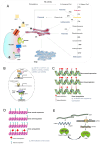Unlocking the potential of flavonoid biosynthesis through integrated metabolic engineering
- PMID: 40510168
- PMCID: PMC12158926
- DOI: 10.3389/fpls.2025.1597007
Unlocking the potential of flavonoid biosynthesis through integrated metabolic engineering
Abstract
Flavonoids are a diverse class of plant polyphenols with essential roles in development, defense, and environmental adaptation, as well as significant applications in medicine, nutrition, and cosmetics. However, their naturally low abundance in plant tissues poses a major barrier to large-scale utilization. This review provides a comprehensive and forward-looking synthesis of flavonoid biosynthesis, regulation, transport, and yield enhancement strategies. We highlight key advances in understanding transcriptional and epigenetic control of flavonoid pathways, focusing on the roles of MYB, bHLH, and WD40 transcription factors and chromatin modifications. We also examine flavonoid transport mechanisms at cellular and tissue levels, supported by emerging spatial metabolomics data. Distinct from conventional reviews, this review explores how plant cell factories, genome editing, environmental optimization, and artificial intelligence (AI)-driven metabolic engineering can be integrated to boost flavonoid production. By bridging foundational plant science with synthetic biology and digital tools, this review outlines a novel roadmap for sustainable, high-yield flavonoid production with broad relevance to both research and industry.
Keywords: artificial intelligence; flavonoid biosynthesis; metabolic engineering; plant cell factory; transcriptional regulation.
Copyright © 2025 Wang, Chen, He, Yin and Liao.
Conflict of interest statement
The authors declare that the research was conducted in the absence of any commercial or financial relationships that could be construed as a potential conflict of interest.
Figures



Similar articles
-
A review of MicroRNAs and flavonoids: New insights into plant secondary metabolism.Int J Biol Macromol. 2025 May;309(Pt 1):142518. doi: 10.1016/j.ijbiomac.2025.142518. Epub 2025 Mar 27. Int J Biol Macromol. 2025. PMID: 40157676 Review.
-
Designing plant flavonoids: harnessing transcriptional regulation and enzyme variation to enhance yield and diversity.Front Plant Sci. 2023 Jul 28;14:1220062. doi: 10.3389/fpls.2023.1220062. eCollection 2023. Front Plant Sci. 2023. PMID: 37575923 Free PMC article. Review.
-
Advances in Flavonoid and Derivative Biosynthesis: Systematic Strategies for the Construction of Yeast Cell Factories.ACS Synth Biol. 2024 Sep 20;13(9):2667-2683. doi: 10.1021/acssynbio.4c00383. Epub 2024 Aug 15. ACS Synth Biol. 2024. PMID: 39145487 Review.
-
Significance of miRNA in enhancement of flavonoid biosynthesis.Plant Biol (Stuttg). 2022 Mar;24(2):217-226. doi: 10.1111/plb.13361. Epub 2021 Nov 21. Plant Biol (Stuttg). 2022. PMID: 34806280 Review.
-
Transcriptional control of flavonoid biosynthesis by MYB-bHLH-WDR complexes.Trends Plant Sci. 2015 Mar;20(3):176-85. doi: 10.1016/j.tplants.2014.12.001. Epub 2015 Jan 8. Trends Plant Sci. 2015. PMID: 25577424 Review.
References
-
- Addi M., Elbouzidi A., Abid M., Tungmunnithum D., Elamrani A., Hano C. (2022). An overview of bioactive flavonoids from citrus fruits. Appl. Sci. 12, 29. doi: 10.3390/app12010029 - DOI
-
- An J.-P., Wang X.-F., Zhang X.-W., Bi S.-Q., You C.-X., Hao Y.-J. (2019). MdBBX22 regulates UV-B-induced anthocyanin biosynthesis through regulating the function of MdHY5 and is targeted by MdBT2 for 26S proteasome-mediated degradation. Plant Biotechnol. J. 17, 2231–2233. doi: 10.1111/pbi.13196 - DOI - PMC - PubMed
-
- Baskar V., Venkatesh R., Ramalingam S. (2018). “Flavonoids (antioxidants systems) in higher plants and their response to stresses,” in Antioxidants and Antioxidant Enzymes in Higher Plants. Eds. Gupta D. K., Palma J. M., Corpas F. J. (Cham, Switzerland: Springer International Publishing; ), 253–268. doi: 10.1007/978-3-319-75088-0_12 - DOI
Publication types
LinkOut - more resources
Full Text Sources

